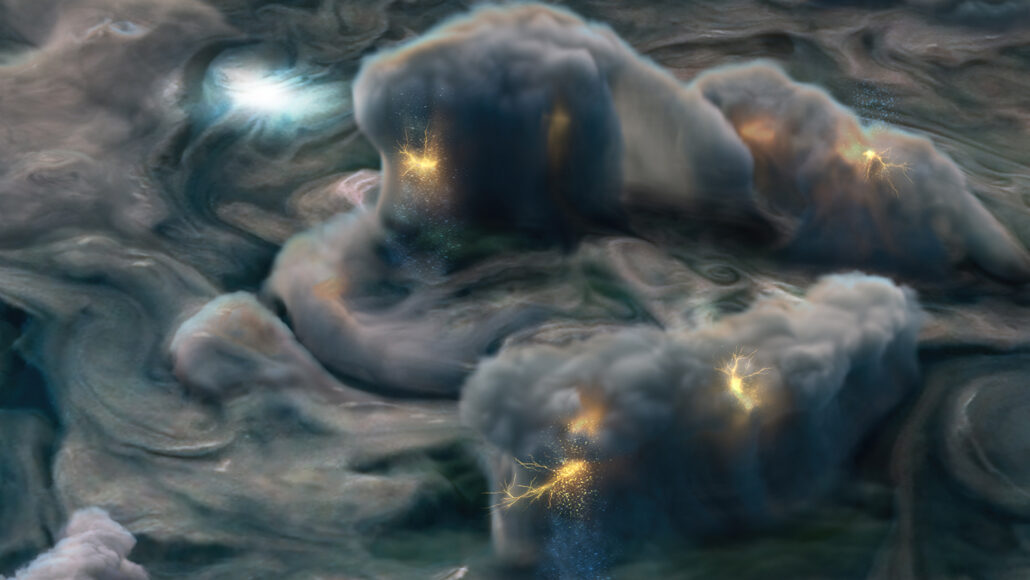Lightning dances through Jupiter’s skies much like it does on Earth
Water and ice might build electric charge in thunderclouds on both planets

Lightning extends through Jupiter’s thunderclouds (illustrated) at a rhythm similar to bolts on Earth.
Gerald Eichstädt, MSSS, SwRI, JPL-Caltech/NASA
By Nikk Ogasa
On Jupiter, lightning jerks and jolts a lot like it does on Earth.
New views of storms on Jupiter hint that its lightning bolts build by lurching forward. What’s more, those staggering steps happen at a similar pace to lightning bolts on our own planet.
Arcs of lightning on both worlds seem to move like a winded hiker going up a mountain, says Ivana Kolmašová. A hiker might pause after each step to catch their breath. Likewise, lightning on Earth and Jupiter both seem to build by “one step, another step, then another,” Kolmašová says. She’s an atmospheric physicist at the Czech Academy of Sciences in Prague. Her team shared the new findings May 23 in Nature Communications.
The discovery about Jupiter’s lightning doesn’t just offer new insights into this gas giant. It could also help aid in the search for alien life. After all, experiments hint that lightning on Earth could have forged some of the chemical ingredients for life. If lightning works a similar way on other worlds, it might produce life’s building blocks on distant planets, too.
Lightning, step by step
Here on Earth, winds within thunderclouds whip up lightning. The winds cause many ice crystals and water droplets to rub together. As a result, those tiny bits of ice and water become electrically charged. Bits with opposite charges move to opposite sides of the clouds, building up charge on either end.
When that charge buildup gets big enough, electrons are released — the lightning takes its first step. From there, the surging electrons repeatedly rip electrons off molecules in new segments of air and rush into those segments. So the bolt of lightning leaps forward at tens of thousands of meters per second, on average.
Scientists thought Jupiter’s lightning might also form by ice crystals and water droplets colliding. But no one knew whether the alien bolts grew step by step, as they do on Earth, or if they took some other form.
Views from Juno
Kolmašová’s group looked at data from NASA’s Juno spacecraft. Specifically, they looked at pulses of radio waves given off by Jupiter’s lightning. The data included hundreds of thousands of radio wave pulses from lightning over five years.
Radio waves from each lightning bolt seemed to happen about once per millisecond. On Earth, lightning bolts that stretch from one part of a cloud to another pulse at about the same rate. This hints that Jupiter’s lightning builds in steps that are hundreds to thousands of meters long, too.
Step-by-step lightning is not the only possible explanation for what Juno saw, says Richard Sonnenfeld. He’s an atmospheric physicist who wasn’t involved in the study. He works at the New Mexico Institute of Mining and Technology in Socorro.
The radio pulses could have come from electrons running back and forth along bolts of lightning, Sonnenfeld says. On Earth, such currents cause some bolts to appear to flicker. Still, he says, stop-and-go lightning formation is “a perfectly reasonable explanation” for the data.







